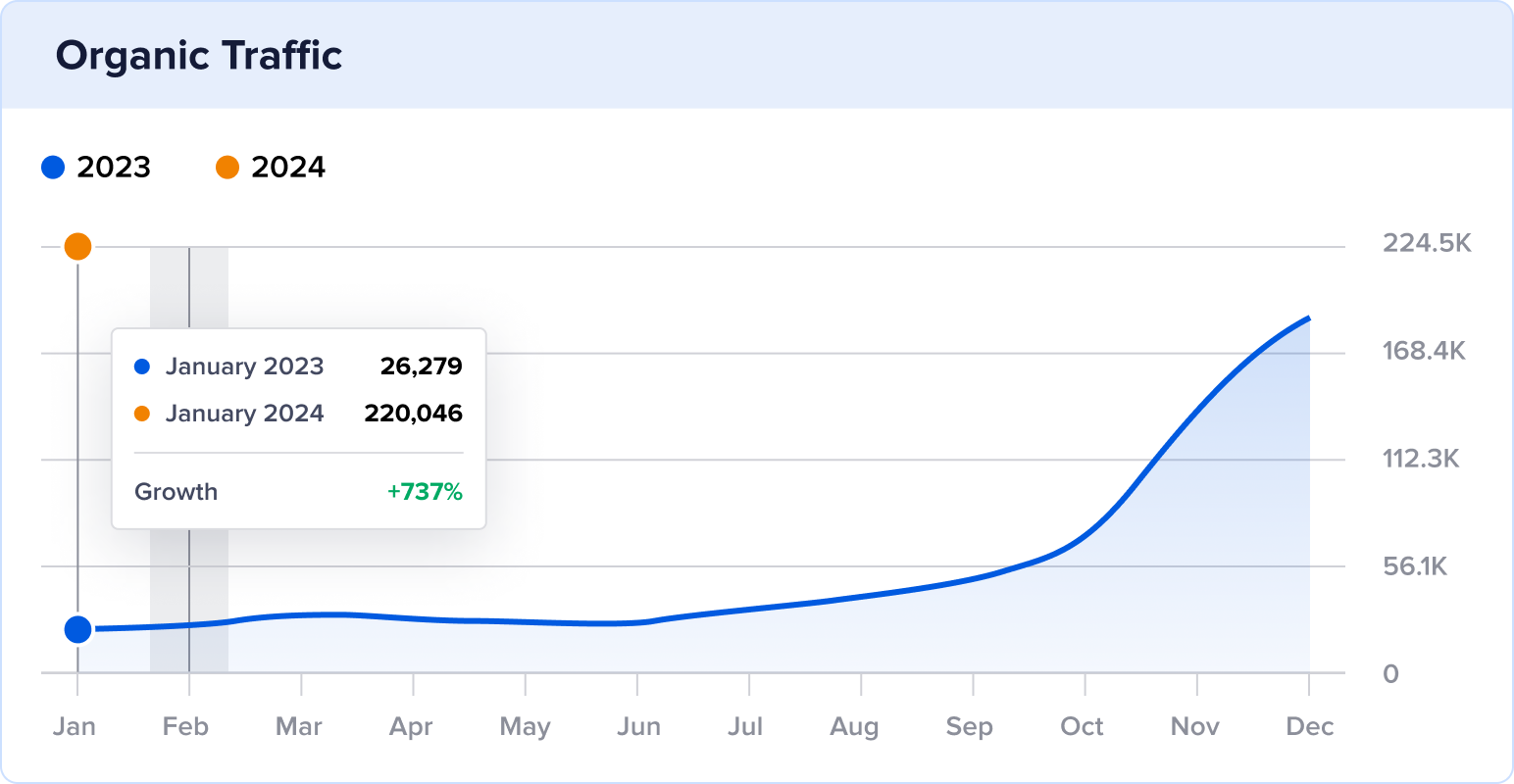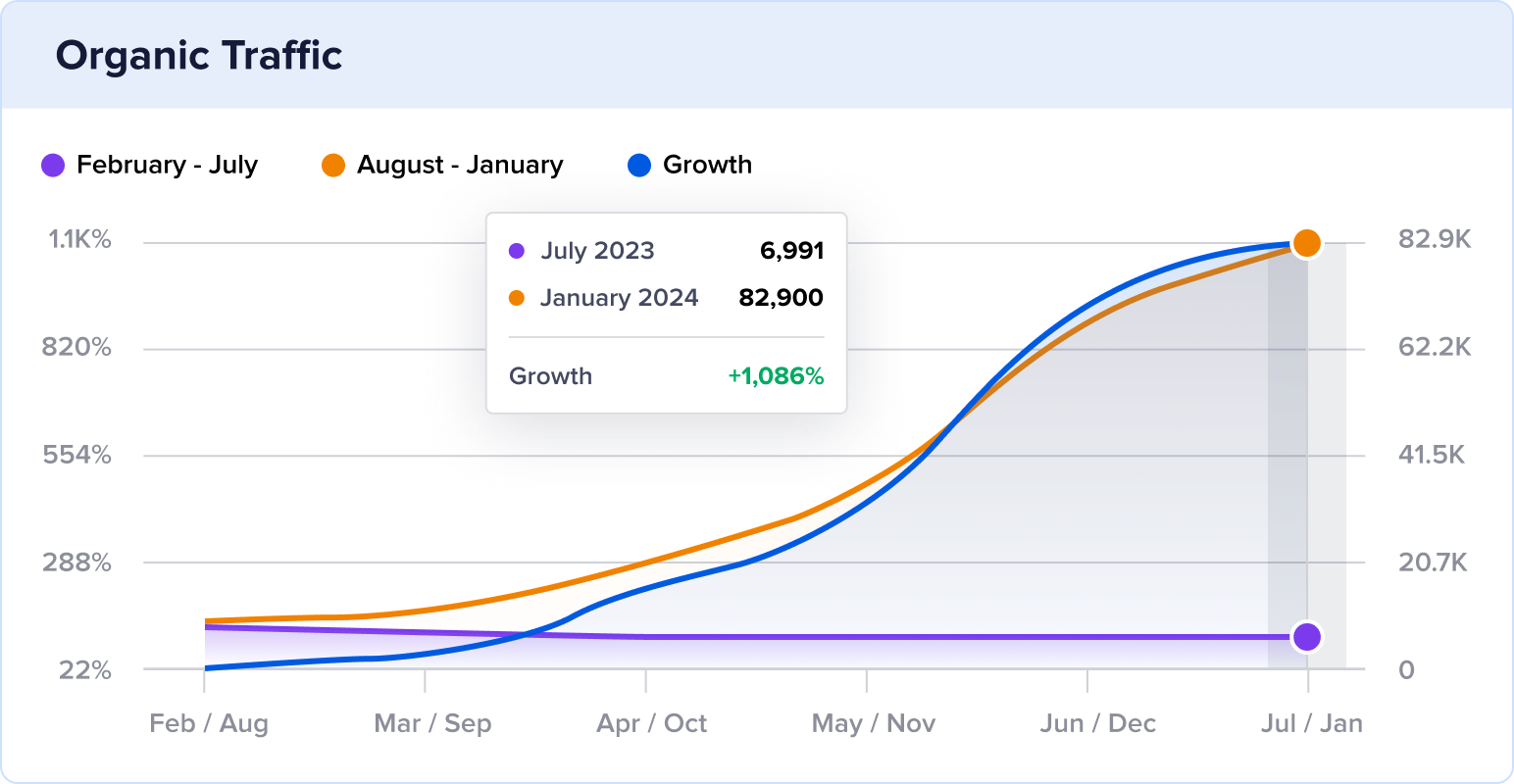How a Food Blog Grew Traffic from 77K to 1 MILLION in 2 Months
https://www.100daysofrealfood.com/
Stats
77.5K to 1M Monthly Visits
Industry
Food & Drink
Niche
Food Blog
Reporting Date
August 2023
Food blogs are the highest-paying niche, making it the most competitive market for bloggers.
But with over 7.5 million blogs published daily, do individual-run blogs stand a chance?
It can be done, and 100 Days of Real Food is the proof.
In this SEO case study, we’ll share how this clean food blog is dominating the search engine results page (SERP) to skyrocket its traffic by 1,198%.
Join us as we explore 100daysofrealfood.com and reveal the strategies behind its success.
In This Article
About 100 Days of Real Food
Lisa Leake started 100 Days of Real Food in May 2010.
What began as a simple pledge to remove processed foods from the family-of-4’s diet transformed into a website to document the journey.
Enter 100daysofrealfood.com

Over the next 13 years, Leake expanded her original passion project into a full-blown food blog.
Today, 100 Days of Real Food is a go-to source for clean eating.
Leake makes it easy for her audience to learn the ropes of eating non-processed foods and juggle busy family schedules with healthy meals.
The website has a distinct target audience, guided by a blogger and author who embodies the principles she promotes.
Because of this, Lisa Leake has fostered a dedicated community of loyal readers.
Their Facebook account boasts 1.2 million followers, and the newsletter has a 46,000 readership with a 50% open rate.
These are impressive metrics for an individual who has carved a space in the competitive food blogging market.
Historical Performance
100 Days of Real Food didn’t reach these numbers overnight.
There are 13 years of experience, time, and effort behind this blog.
Historical data reveals monthly traffic stayed below 300K visits, excluding July and August 2023.
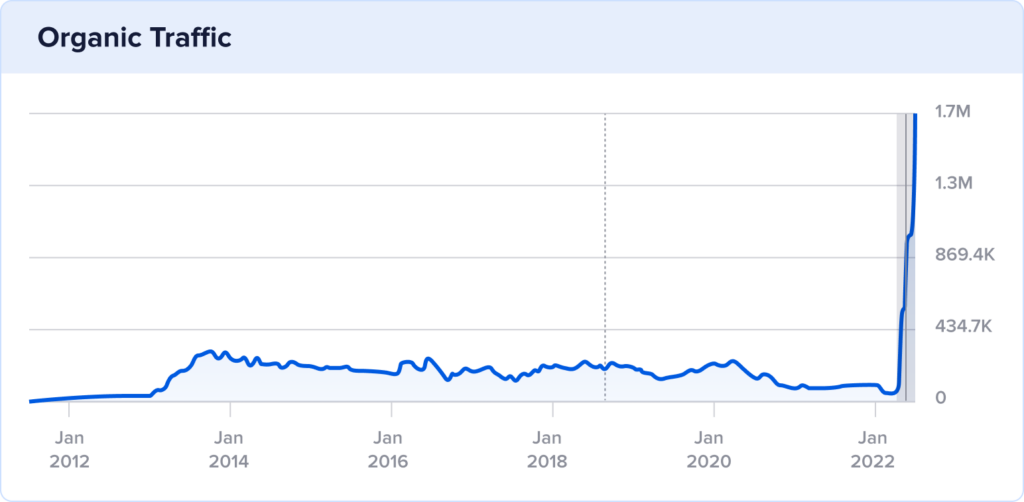
In the most recent year, 100 Days of Real Food amassed 1,085,930 total visits in 2022.
As we analyzed this website in August 2023, the traffic has nearly doubled.
And we’re only 8 months into the year!
For 2023 thus far, the site boasts a staggering 2,072,085 visits, with the majority stemming from July and August—a trend we’ll delve into next.
So, what exactly happened to catapult this 13-year-old website to unprecedented heights this year?
Let’s uncover the strategies behind this ascent.
The Catalyst: How 100 Days of Real Food Grew Traffic by 1,198% in 2 Months
100daysofrealfood.com grew organic traffic by performing the following:
- Adding measurement blogs
- Optimizing for featured snippets
- Implementing schema markup
We’ll examine these items in detail to understand their significance and why they catapulted 100 Days of Real Food’s success.
1. Adding Measurement Blogs
Between June and August, 100 Days of Real Food added 14 measurement blogs to its site.
The blogs are straightforward and fulfill search intent by answering common measurement questions related to cooking.
Here’s an example from the site’s top-ranking blog:

While the blogs themselves aren’t particularly remarkable, their results are.
These 14 pages account for 421K US monthly visits.
That’s 82.4% of the total traffic.
Here is a list of the site’s top pages, where 9 out of 10 URLs are measurement blogs:

Why this matters:
By identifying a new category of content, 100 Days of Real Food was able to tap into the ranking potential of high-traffic, long-tail keywords. The topic is also relevant to its niche, making it a natural fit for the website. Relevancy is important when building out content because it helps establish authority in the eyes of your audience and search engines.
How to find relevant keywords for your site:
Identifying new content opportunities starts with keyword research.
This keyword research guide explains how to do it using popular SEO tools.
In a nutshell, you’ll perform the following steps:
- Start your search with a broad term. (For example, if you’re a clothing e-commerce, you may start with “shirts.”
- Find related keywords.
- Export all keyword ideas into a spreadsheet.
- Rinse and repeat steps 1-3 for new terms.
- Organize keywords using topic clusters to start building your content strategy.
Tools for finding relevant keywords in WordPress:
Did you know you can perform keyword research without ever leaving WordPress?
All in One SEO (AIOSEO) makes this possible with Semrush Keyphrase Suggestions.
Once you’ve added a focus keyphrase to your blog, you can get additional keyphrases in just 1 click.
Here’s an example of the keyword suggestions for a patio furniture blog:
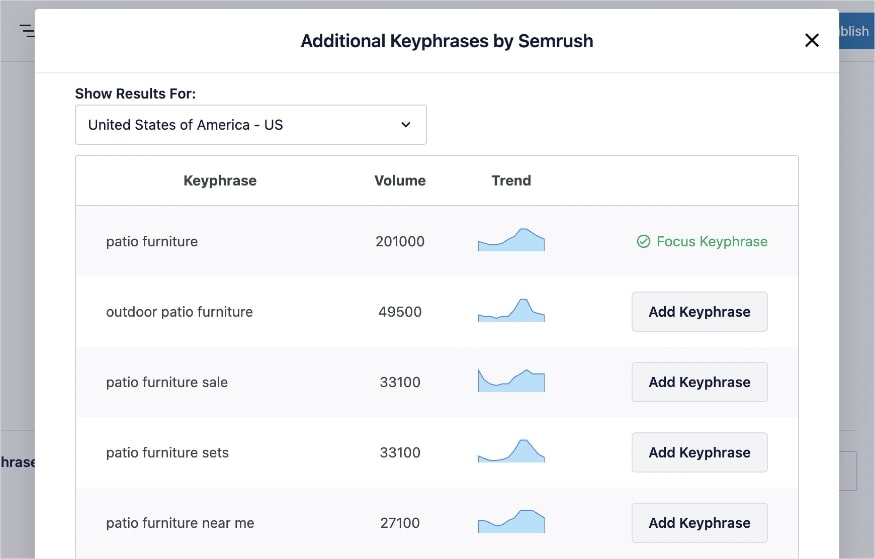
The results will be relevant to your primary keyword and can help you identify long-tail keyword opportunities.
Long-tail keywords use 3 or more words when someone searches for something specific. These keywords are SEO gold because they have less competition, focused user intent, and high conversion rates.
After adding a related keyphrase, AIOSEO will check your content for this new keyword. It will then give you a TruSEO Score, reflecting how well you optimized for it.
Now, as we look at 100 Days of Real Food’s new content, it’s important to discuss why these pages are getting so much attention.
That’s the power of featured snippets on the SERP.
2. Optimizing for Featured Snippets
With food blogs being the most profitable blog niche, there’s no shortage of competition.
That’s why you have to stand out.
Featured snippets are a powerful way for websites of all sizes to win the coveted position 0 on the SERP.
These results appear at the top of the page and answer the user’s search query directly on the SERP.
Here is one of 100 Day of Real Food’s featured snippets:

Why this matters:
Featured snippets have an impressive 35% clickthrough rate (CTR). They’re proven to drive traffic and can help boost brand awareness.
They’re also particularly effective if you already have content ranking on page 1 of the SERP.
If your content is struggling to climb higher, optimizing for a featured snippet could make the difference in getting you on top.
How to optimize for featured snippets on your site:
Featured snippets can be elusive, but here are strategies to get them.
100 Days of Real Food is a prime example, as evidenced by their top 4 keywords getting featured snippets.
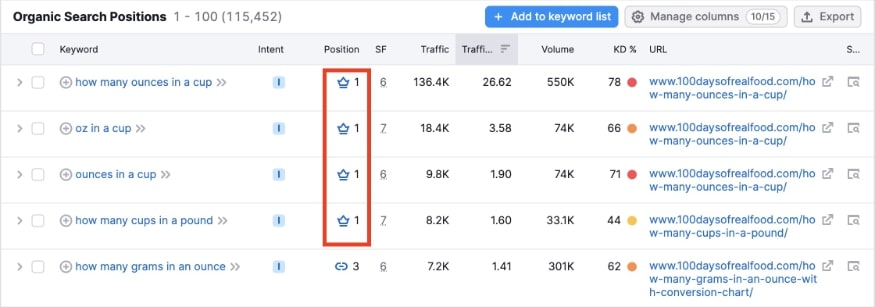
Here is what they’re doing with their content to win these traffic-boosting search results and what you can do on your website:
- Using a clear, organized structure for its content – A well-defined structure can make it easier for Google to understand your content and its hierarchy. And the easier search engines understand your page, the more likely you are to rank.
- Fulfilling keyword intent – It’s critical to meet the search intent for the keyword. By understanding what the user is looking for, you can more accurately tailor your content to fulfill their needs.
- Keeping it concise – Featured snippets are relatively short, so Google prefers concise answers over long ones.
- Implementing schema markup – While schema markup doesn’t directly impact featured snippets, it does help search engines understand your content. And as we saw in point #1, this is crucial for upping your chances at ranking.
- Establishing authority in its niche – Featured snippets are challenging to get as a one-time instance. You need to be doing several things correctly on your site and have credibility in the eyes of Google. Featured snippets are a long-term goal.
If you’d like to learn more about featured snippets, this beginner’s guide has everything you need to know about optimizing your content for them.
Tools for featured snippets:
At its core, winning a featured snippet is about creating high-quality content and fulfilling search intent.
AIOSEO’s TruSEO Analysis can help you understand your optimization efforts to unlock your content’s full potential.
TruSEO gives you a score and checklist of items that make it easy to understand where you excel and what needs tweaking. We’ll also give you recommendations for making any adjustments.
Here’s an example of readability suggestions and a TruSEO score of 90/100:

Curious about the 69/100 score, too?
That’s our Headline Analyzer! This tool gives you real-time feedback on your headline optimizations, making writing great titles a breeze.
Now, let’s look at how 100 Days of Real Food uses schema markup to go beyond featured snippets and win rich results.
3. Implementing Schema Markup
As we just saw, schema markup can help search engines more easily understand the content and context of your web page.
In its raw form, schema markup is specialized code in the form of structured data. It communicates the content behind your page and tells search engines how you want it displayed on the SERP.
Here are a few types of structured data:
- Recipe
- How-To
- Product
- Article
- Reviews
Ultimately, the goal of schema markup is to get rich results. Rich results (or rich snippets) present additional information directly on the SERP.
Here’s an example of how structured data translates to a rich result:
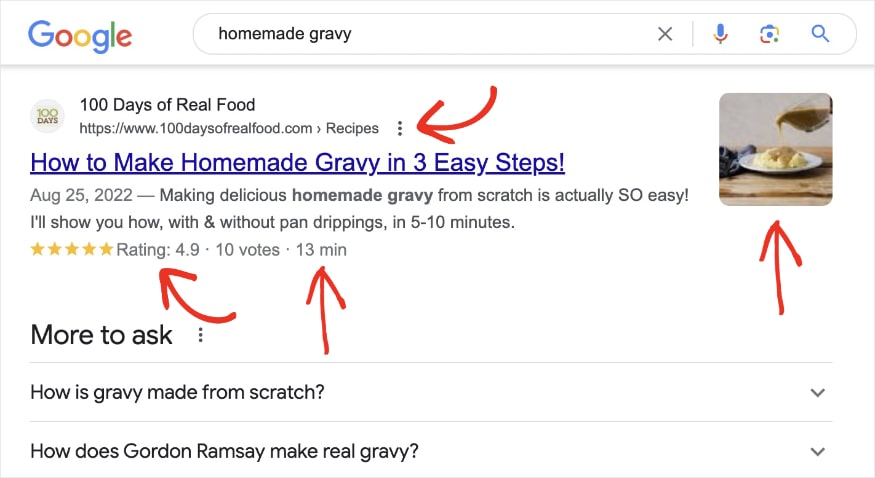
Rich results (or rich snippets) present additional information directly on the SERP.
In the above example, we see a handful of schema types:
- Breadcrumb
- Review
- Recipe (Cook time)
- Image
100 Days of Real Food excels in implementing schema markup on its website. Their generous usage of structured data is evident, with several types on every page we reviewed.
These efforts have yielded significant results in recent months.
Semrush reveals a natural progression, with August 2023 having the most significant growth.
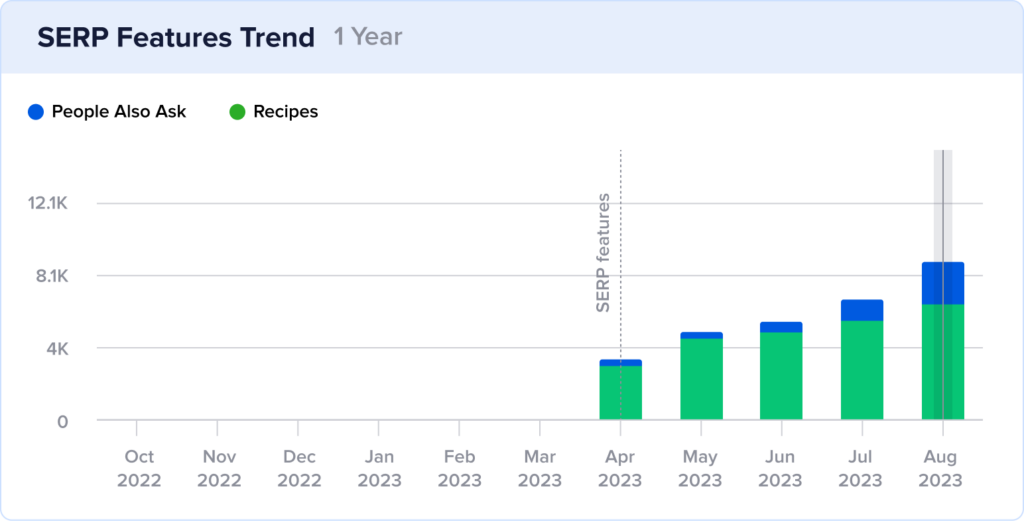
Note: Semrush did not track SERP features before April 2023, so no data is available before this date.
This growth mirrors the increase in traffic, too:
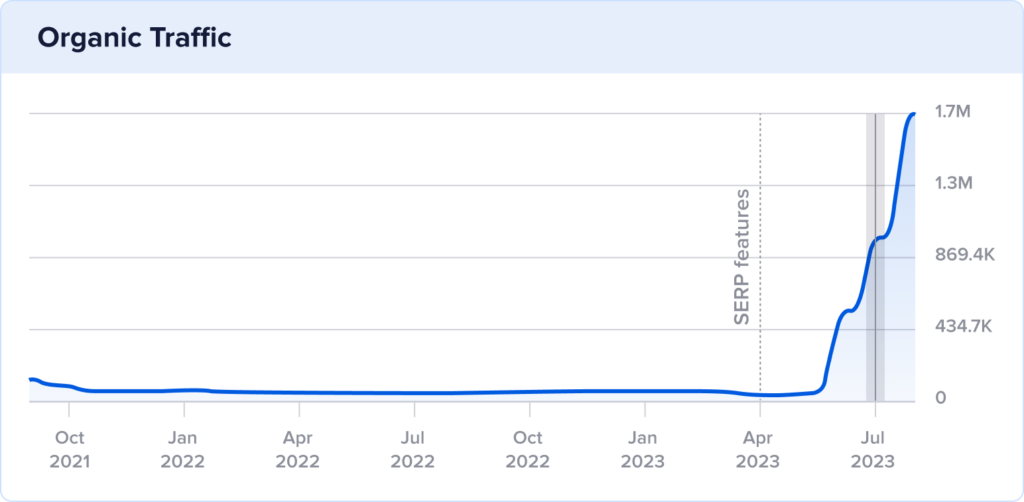
Why this matters:
100 Days of Real Food demonstrates the effectiveness of schema markup to secure enhanced results on the SERP. The substantial increase in traffic underscores the power of this SEO strategy.
How to implement schema markup on your site:
You can manually input structured data on your website in various ways.
This article shows three methods for adding schema markup to WordPress without a plugin.
Each method involves a few steps and requires you to obtain and copy code snippets into the appropriate fields.
Tools for implementing schema markup:
Touching code can be intimidating, so let a WordPress SEO plugin do the work for you. AIOSEO’s Schema Generator allows you to pick the schema type you want, and we’ll implement it.
Here are the available schema types in AIOSEO:

Standout SEO Wins
Before we conclude, there are two SEO techniques worth highlighting on 100daysofrealfood.com:
1. They have an effective internal linking strategy.
100 Days of Real Food thoughtfully sprinkles internal links throughout its content. The links are natural and enhance the user experience instead of distracting from it.
They also use descriptive anchor text, which plays an essential role for users and search engines.
Anchor text is the clickable part of a hyperlink. It helps users and bots understand what the page is about, providing context and SEO signals.
Tool: Internal linking can be meticulous, but tools like All in One SEO’s Link Assistant simplify the process. This feature lets you identify relevant content and add internal links with a single click.
Here’s an example of linking suggestions from Link Assistant:
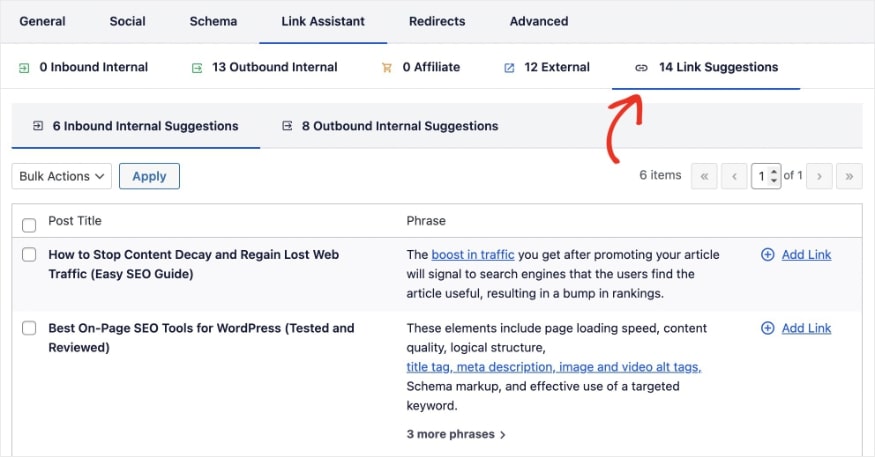
2. They optimize for content readability.
Content readability measures how easily users can read and understand your content. It is determined by various factors, such as word choice, sentence length, syllable count, and more.
While it is not a direct Google ranking factor, having easy-to-understand content can improve certain SEO metrics, like time on page and bounce rate.
100 Days of Real Food does the following to improve readability:
- There is a good distribution of subheadings. They use subheadings to structure their content, aiding users and search engines in navigating their pages.
- Language is simple and easy to understand. Lisa Leake and other 100 Days of Real Food authors use everyday language in their blogs. It’s fluid, natural, and conversational.
- Multimedia breaks up blocks of text. Images and videos help to keep your audience engaged.
Tool: TruSEO Analysis simplifies content readability and provides actionable recommendations for improvement directly in the WordPress editor.
Below is an example of the readability checklist and tips for improving it.
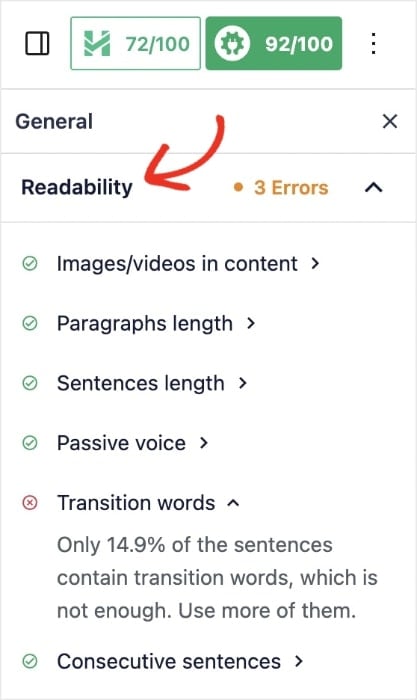
Takeaways
In our analysis of 100daysofrealfood.com, we’ve discovered the main factors contributing to its sudden growth in traffic.
Now, let’s review which strategies to apply to your site and which ones to reconsider.
Top 3 Strategies to Emulate
- Find relevant keywords to build out content. 100 Days of Real Food identified new ranking opportunities and created content to capture this traffic. They strategically chose a topic that aligns with their niche and complements the user experience. This also helps to build authority in the eyes of search engines.
- Optimize for SERP features to reach the top of page 1. By mastering the art of content structuring, schema markup, and search intent, 100 Days of Real Food has won several SERP features. These results appear at the top of the SERP and drive targeted traffic to your site.
- Implement schema markup to win rich results. While schema markup doesn’t guarantee a rich result, it increases your chances. By using structured data, you can win eye-catching real estate on the SERP and increase your CTR.
Bottom 3 Strategies to Reconsider
- Overlooking image title tags. Image SEO plays a critical role in food blogs, where visuals are essential. Images should include alt text and title tags to improve the user experience and support search engine crawling. AIOSEO makes this process easy with smart tags that generate image titles for you.
- Relying on one type of content. While the new measurement blogs have attracted substantial traffic, 100 Days of Real Food shouldn’t rely on this category alone. Content diversification is essential to maintain a consistent traffic flow and reduce the risk of over-reliance on a single category. Semrush Keyphrase Suggestions can help you identify relevant keywords and new content opportunities.
- Exceeding metadata character limits. While most metadata is optimized, some titles and descriptions exceed character limits, resulting in a truncated search result. An easy fix to this issue is to review all metadata using a SERP snippet tool before publishing. This will show you a preview of your page on the SERP.
Steal Our SEO Winning Strategy: A Checklist for Your Website
Ready for your blog to dominate its niche on the SERP?
We’ve got you covered with our comprehensive SEO checklist—your action plan to victory.
Download A Free SEO Checklist
Access our comprehensive SEO Checklist with a single click. We’ll deliver it straight to you, putting actionable items with SEO tools and tutorials right at your fingertips.
Enter your name and email to download a free SEO checklist.

Unlock Your Site’s Recipe for Success With AIOSEO
Time is your most valuable asset when you’re running a blog solo.
An SEO WordPress plugin like All in One SEO can be your secret weapon, turning manual tasks into automated workflows.

Trusted by over 3 million savvy bloggers and marketers, AIOSEO offers a robust tool kit that makes it easy to do SEO and get results. We’ll help you drive targeted traffic to your site and make optimizations like a pro.
Here are a few of our favorite features:
- Semrush Keyphrase Suggestions: Find new keywords without ever having to leave WordPress. AIOSEO connects with your Semrush account to pull keyphrase suggestions from its database and serve them to you directly in the WordPress editor.
- TruSEO On-Page Analysis: Get comprehensive but easy-to-understand feedback on your content optimizations. We’ll let you know which elements meet SEO and readability standards and give you actionable insights for those that need tweaking.
- Rich Snippets Schema: AIOSEO offers several schema types to help you win more rich results on the SERP. It’s as simple as choosing the schema you want; then, we’ll format the structured data for Google.
- Image SEO: Set automatic image alt text and title tags with 1 click. You’ll save time on manual optimizations while helping users and search engines understand your images.
- Link Assistant: Apply internal linking best practices with linking suggestions and reports. These tools will help you boost content discovery and prevent orphan pages on your site.
- Social Media Integration: Connect with your audience and share content across all your social media platforms. Some integrations include Facebook, Instagram, Twitter, LinkedIn, Pinterest, and more.



